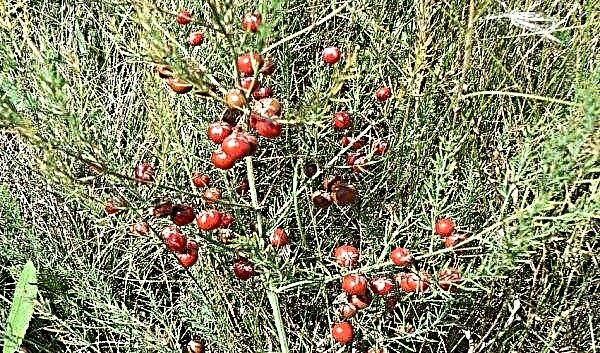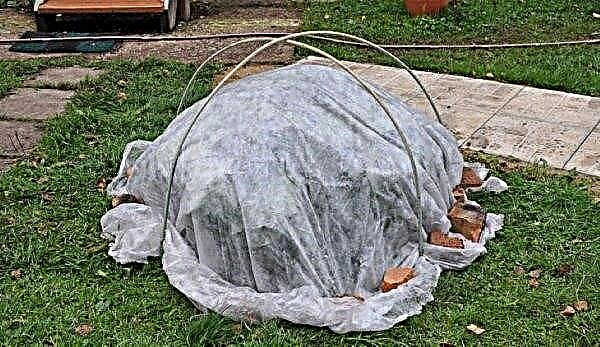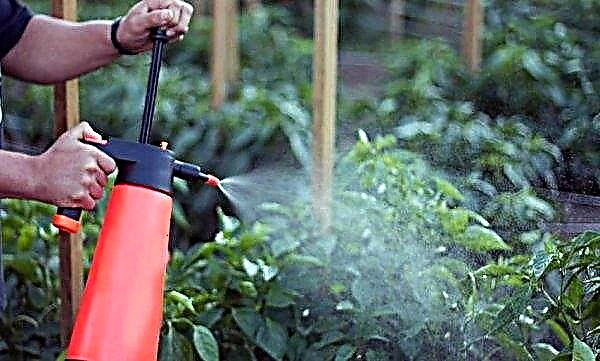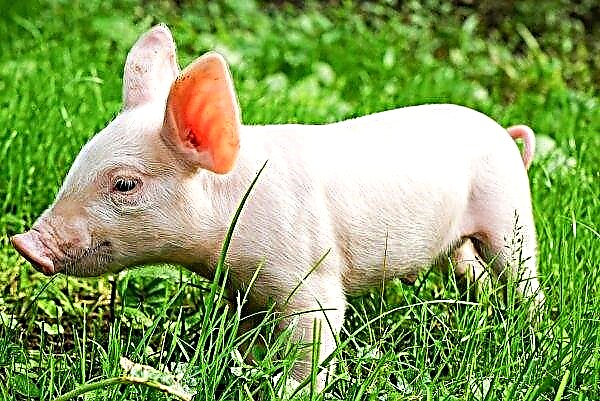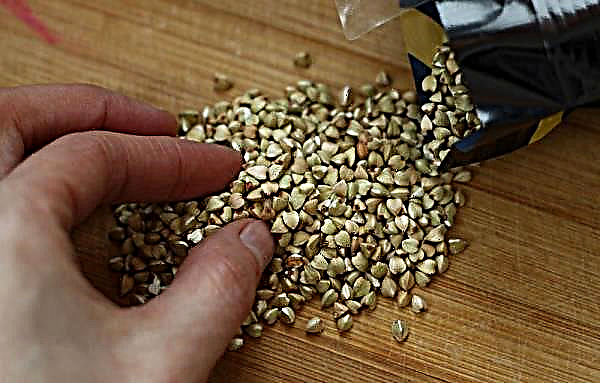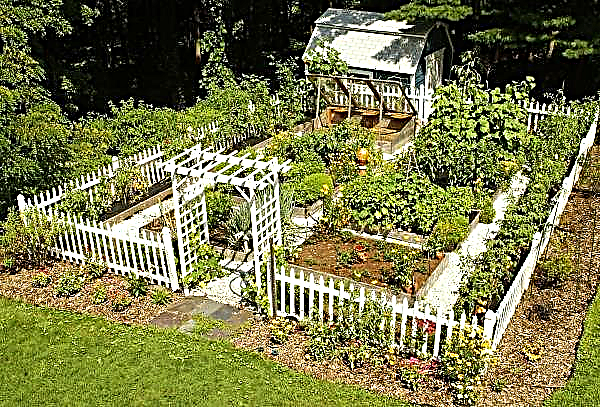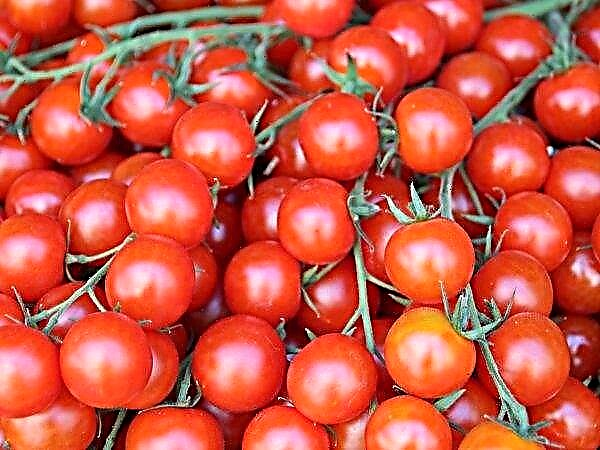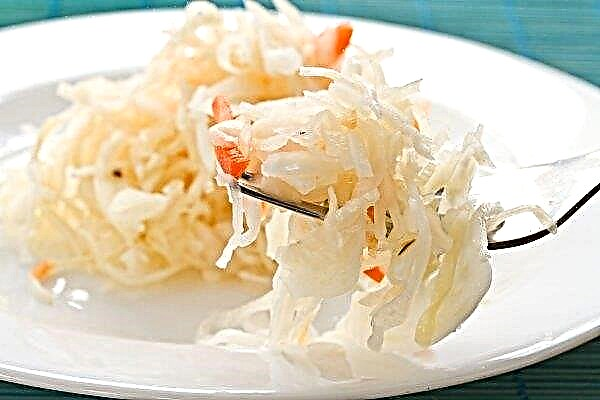A plant with an unusual and difficult to remember name exakum attracts gardeners with an unusual appearance, abundant flowering, wonderful aroma. However, in order to achieve the beauty of this flower, you should try - he needs high-quality and regular care, as well as certain conditions. More on this later in the article.
What is exakum: a description of the plant
The ezacum is a two-year-old herbaceous flowering plant of compact size, which is ranked as the Gorechavkov family. The height of the bush reaches 20-30 cm. The shape of the crown resembles a ball. The root system of the plant is superficial, fibrous. The stems of the flower grow straight. The leaves are oval, saturated green, with smooth edges. Grow in length by 3.5 cm. Placed on short petioles. Each leaflet contains 1-3 bright veins. During flowering, the entire bush is covered with small flowers with a diameter of 1 cm, consisting of 5 lilac-blue petals and a yellow eye in the center.
From them comes a gentle pleasant aroma. The exacum homeland is considered to be the eastern and southern regions of Asia, the Malay archipelago, and the island of Socotra. At home, about 30 species are cultivated, most often exakum related and exakum trehgilovy. The plant is also found under the name Persian Violet. At home, it is used to decorate rooms for various purposes, a balcony, a loggia, a veranda.
Did you know? The Guinness Book of Records recorded the record for creating the largest chandelier made of fresh flowers. It had a height of 17 m and a length of 10 m. 260 students of schools and universities, gardeners, and park employees worked on its creation.
Conditions for growing in the house
Like most exotic plants, exakum loves light, heat and high humidity. If you do not create optimal conditions for him in the house, he will significantly reduce his decorativeness and the abundance of flowering.
Location and Lighting
The flower pot should be placed in a well-lit place. The more light a bush receives, the more magnificent its flowering. The plant is not afraid of direct sunlight, so it can be grown on the southern, western, eastern window sills. Growing from the north side is undesirable for him, additional illumination is required here. During the cultivation, it is advisable not to change the location of the flower and the intensity of lighting, as this can adversely affect its appearance and flowering.
Temperature and humidity
The optimum temperature at which the flower feels good and develops is from + 16 ° C to + 20 ° C. He does not have a clearly defined dormant period, so there is no need to specially lower the temperature for the winter. The maximum low temperature that a flower can withstand is + 13 ° C. If the thermometer column drops below, then the plant has leaf fall and wilting. Destructive for this indoor culture and temperature jumps, as well as drafts. In the summer heat, it is advisable to take the flower out into the open air. Exakum should be grown with high humidity - above 60%.
Did you know? In 2018, Ecuador created the largest sculpture of fresh flowers. When it was created, 564 thousand roses were used. It was made by 1,5 thousand local residents.
Home Care
Caring for exakum at home involves regular activities such as moisturizing the soil and air, fertilizing, transplanting. If necessary, treatment against diseases and harmful insects will be required.
Watering and feeding
Exzakum loves well-moistened, but not flooded soil. The next watering should be carried out as soon as the upper soil layer is slightly dry. It is impossible to allow waterlogging, since this threatens the development of root rot. The optimal frequency of soil moisture is 2-3 times a week. In winter, the number and volume of irrigation should be reduced to 1 time in 1-1.5 weeks. Irrigation should be carried out with warm tap water, which is left to stand for 1-2 days or passed through a filter that cleans harmful impurities and chlorine. In order to maintain the required level of air humidity, the bush should be sprayed regularly, kept on a pallet with wet expanded clay or pebbles or near an aquarium, installed an air humidifier. To achieve maximum decorativeness, the plant needs to be fed. The recommended frequency of fertilizer application is 1 time in 10-14 days. For feeding, any liquid universal fertilizer designed for indoor plants is suitable.
In order to maintain the required level of air humidity, the bush should be sprayed regularly, kept on a pallet with wet expanded clay or pebbles or near an aquarium, installed an air humidifier. To achieve maximum decorativeness, the plant needs to be fed. The recommended frequency of fertilizer application is 1 time in 10-14 days. For feeding, any liquid universal fertilizer designed for indoor plants is suitable.
Important! Fertilizers need to be applied only during the growing season - from March to October. In late autumn and winter, feeding is not necessary, it will only harm the plant.
Pruning
Pruning is not needed for this plant. Young shoots independently form a spherical crown. But in order for flowering to be as abundant as possible, it is necessary to remove faded buds in a timely manner.
Transfer
Exacum is transplanted in the spring. Since it does not grow for a long time, this procedure will have to be performed only 1-2 times. For exakum, it is necessary to pick up a small pot with a diameter of 7-10 cm. It can be either plastic or ceramic of any configuration. Land for planting can be purchased at the store ready-made. Loose and light soil with good air and moisture permeability, with a slightly acidic or neutral pH level (5 to 7) is suitable.
It can also be prepared independently, using the following components:
- turf land;
- sheet earth;
- leaf humus;
- peat;
- sand.
The transplant technology is as follows:
- At the bottom lay a three-centimeter layer of drainage from expanded clay, pebbles, shards of clay or other materials.
- Pour a small layer of soil on top.
- Set the bush in the center of the pot.
- Fill the voids with soil so that 1.5–2 cm remains from the edge of the pot.
- Water the flower abundantly.
- If necessary, after shrinkage, add the top layer of soil substrate.
Flowering period
The first flowers appear in May. Flowering lasts until autumn. Flowers are formed so abundantly that sometimes no leaves or stems can be seen behind them. The most magnificent flowering is observed in the second year. After the buds of the biennial have faded, it is inexpedient to keep the winter, since it can no longer be obtained from the former. You need to propagate the flower and grow young bushes.
Breeding methods
Exzakum propagated in two ways: vegetative and seed. And the first and second to produce at home is easy.
Seeds
Seeds and soil and peat soil for their planting can be purchased at a specialized store. Sowing is done in the fall. Moistened soil substrate should be poured into a long flat tank. Pour seeds onto its surface, evenly distributing them. Next, the container must be covered with glass and put in a well-lit warm place. The substrate is moistened as the top layer dries. Every day, in order to ensure the flow of fresh air to the seedlings and prevent the development of fungal infections, the glass must be removed for 15-20 minutes. After sprouts appear, after about 14-18 days, it is completely removed. As soon as the sprouts grow 4 leaves, they are dived into separate pots. Look after the same way as for adult plants.
Every day, in order to ensure the flow of fresh air to the seedlings and prevent the development of fungal infections, the glass must be removed for 15-20 minutes. After sprouts appear, after about 14-18 days, it is completely removed. As soon as the sprouts grow 4 leaves, they are dived into separate pots. Look after the same way as for adult plants.
Cuttings
Cuttings are cut in spring from strong, well-developed apical shoots. It is necessary to cut off the processes 8-10 cm long with 2-3 internodes. Rooted cuttings in two ways. At the first, they are placed in water, which is periodically replaced. In the second case, the cuttings are placed in a moist substrate and covered with a plastic bottle. Radicles should be expected after 2-3 weeks. After which the plants are transplanted into permanent pots. To get a very lush bush, 2-3 cuttings can be planted in one pot.
Plant diseases and pests
If the plant is provided with the right conditions and competent care is provided, it will not hurt. Pest attacks and disease damage are observed only in case of erroneous cultivation techniques. So, with waterlogging, the plant may hurt root rot. The disease can be detected during transplantation or suspected in the case of wilting leaves, flowers, stems, growth retardation. To heal a plant, you will need to transplant it into a new pot and soil.
The roots need to be inspected for rot, removed damaged, the places of the cuts should be dried with crushed activated carbon, and healthy specimens should be treated with any systemic fungicide. If most of the roots are damaged, you need to cut the cuttings from the apical shoots and grow a young plant from them. Dispose of the old bush.
Important! When processing indoor plants, one should not forget about personal safety measures - carry out processing only in a well-ventilated place, protecting the body and face with special protective equipment. It is strictly forbidden to consume food and drinks during processing.
Of exakum pests, a spider mite, aphid, and felt can be affected:
- Spider mite can be found on the lower leaf plate. In the course of his life, he leaves cobwebs on the stems and leaves. When it hits a plant, the leaves become covered with brown spots, dry out and fall off. The tick starts when the flower grows in too dry and hot conditions. To prevent its occurrence, it is necessary to maintain high humidity. When a tick appears, you need to moisten the flower well and cover it with a package. Acaricides fight well with insect chemicals. Suitable drugs «Flumayt ”,“ Akarin ”,“ Apollo ”,“ Borneo ”,“ Actellik ”,“ Fitoverm ”.

- Aphid dwells on the lower leaf plate. This is a small sucking insect, measuring up to 1-2 mm. During his attacks, the leaves turn yellow and dry on the plant. Drinking juices from a flower, aphids can lead to its complete death. At the first detection of the presence of insects, you need to treat the bush with soapy water. If this method does not help, treatment with chemicals, for example, Fitoverm, Aktellik, will be required.

- Felt, or mealybug, leaves white clumps on the soil and flower, similar to pieces of cotton wool. The fight against this insect is carried out by wiping the organs of the bush with soapy water, infusions of garlic or tobacco. In the event of a massive lesion, they resort to the help of chemicals “Aktara”, “Biotlin”, “Calypso”, “Confidor”, “Fitoverm”.

Thus, exakum is a beautifully and abundantly flowering houseplant that has a short lifespan of 1-2 years. In order for it to please with abundant and prolonged flowering in summer and autumn, it is necessary for him to create favorable conditions and conduct quality care for him.




